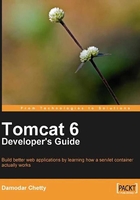
What this book covers
Chapter 1—Introduction to Tomcat introduces you to the Tomcat container and provides you with the tools necessary to begin to take it apart. The key objective of this chapter is to allow you to make a current source distribution of Tomcat active in a development environment (Eclipse Galileo) so that you can trace the path that a request takes through the container's code.
Chapter 2—Servlet API Overview provides the prerequisite information necessary to navigate the remainder of the book. It describes the Java Enterprise Edition Platform, the HTTP protocol, and the Servlet API, and serves as a refresher for those who are already familiar with Java EE web development.
Chapter 3—Servlet Container Overview introduces the reader to the Tomcat container. This is the 10,000 foot overview of the container that provides a backdrop to the chapters that follow. All the components of Tomcat are described with just enough detail, so as not to overwhelm the reader with too much information, too early in the process.
Chapter 4—Starting up Tomcat takes a closer look at the startup process for Tomcat. This is also where you will be first introduced to the Apache Digester project—a key component that we will revisit in later chapters. The chapter ends with an example that demonstrates how a web application can be deployed to a dissected Tomcat container living within an Integrated Development Environment.
Chapter 5—The Server and Service Components discusses the Server component and investigates one of its key services—an implementation of the Java Naming and Directory Interface (JNDI) API. We are also introduced to the Lifecycle interface that almost every component within Tomcat implements in order to participate in a standardized event based listener mechanism. To show JNDI in action, our example considers connecting to a MySQL database to retrieve data.
Chapter 6—The Connector Component introduces our first Tomcat luminary, the Coyote Connector. We take a closer look at the standard Java I/O implementation of an HTTP connector. In this chapter, we get a closer look at socket programming, advanced elements of the HTTP protocol, and the internals of the request processing mechanism.
Chapter 7—The Engine Component describes the first request processing 'Container' within Tomcat and gives us an inkling of things to come. We are also introduced to the Pipeline and its Valves, which are the standard request processing mechanism for Tomcat components.
Chapter 8—The Host Component discusses the Tomcat implementation of a Virtual Host. This is the key component responsible for the deployment of web application contexts, as well as for the error page mechanism.
Chapter 9—The Context Component is at the central core of this book. You get an up-close-and-personal look at how a Context is configured, how it accesses its resources, and how it implements its class loading magic.
Chapter 10—The Wrapper Component takes us to the workhorse of the Tomcat component hierarchy. This component wraps an actual servlet, and as a result is close to a web developer's heart. In addition to reviewing the mapping rules dictated by the Servlet API, we also look at the implementation of servlet filters and the request dispatcher mechanism.
Chapter 11—The Session Component discusses how sessions are implemented in Tomcat to enable stateful behavior over the stateless HTTP protocol. In addition to looking at some core concepts, such as Java serialization and entropy gathering for random number generation, we look at the standard memory based session implementation, as well as an implementation that uses files to persist sessions.